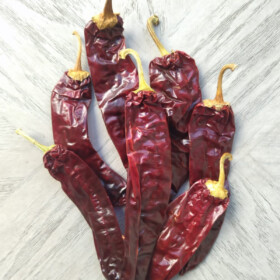Guajillo peppers are one of the most important and widely-used dried chiles in Mexican cuisine. They are a bright red and fruity variety of chile that is typically used to flavor soups and make salsas. Learn how to cook with guajillo peppers like a pro!

What Are Guajillo Peppers?
Guajillo peppers are fresh mirasol chiles that have been dried. Once dried, their name changes to ‘guajillo’, which is their most common form. They’re one of the most popular kinds of chile— being particularly important in northern Mexico, where salsa-based stews heavily rely on them for flavor.
Their maroon skin is flat and smooth, unlike other kinds of dried chile. If you’re not sure what you’re looking for, guajillo peppers look like huge versions of flattened (and red) serranos. Their bodies are long and narrow, ranging from 10-20 cm in length.
Taste-wise, they’re much sweeter than you’d expect from a Mexican pepper. Rather than spicy, their flavor profile is actually very fruity (think plums, prunes, and peaches), tart, tangy, and slightly smokey. Because of their redness, your dishes and salsas will likely adopt their color unless they’re offset by other ingredients.
We use dried Guajillo Peppers to make our favorite Pollo Asado, Chili Colorado and homemade Adobo Sauce.
Substitute Ideas
These are some chiles and combinations of them you can use to substitute guajillo peppers in a recipe:
- Dried ancho chile. Substitute the guajillo peppers for the same amount of chile ancho. Clean, toast, and rehydrate it using the same technique. It will have a smokier flavor and a much deeper, brown-ish color but it’s a quick solution if you’re out of guajillo or can’t find any. For every 5 chiles, add 1/2 teaspoon of white vinegar to add a little bit of tang.
- Dried New Mexico chile. Flavor-wise, they’re very similar to guajillo so substitute it in the same amount. Use the same method to clean, toast, and rehydrate them. It’s very fruity, smokey, and slightly spicy but not more than a guajillo so don’t worry about the heat.
- Dried pasilla chile. Go for the same amount of it as the recipe calls for in guajillo. It’s slightly spicier than chile ancho so that’s just something to keep in mind. It has subtle notes of raisins and dried prunes, so its fruitiness is perfect. Add 1/2 teaspoon of white vinegar for every 6 chiles in the recipe.
- Use a combination. For the best substitute, I like to combine one part chile ancho, one part chile pasilla, one part chile morita, and 2-3 dried chiles chipotle. Don’t forget to clean, toast, and rehydrate the chiles. The combination of sweet, smokey, spicy, fruity, and earthy that this makes is the closest I’ve gotten to recreating the flavor of guajillo.

What Do They Taste Like?
Dried chile guajillo is sweeter than most people would expect, adding a very fruity and floral flavor to anything it’s added to. Once rehydrated and blended, it tastes like a very mild chile sauce with hints of vinegar.
Its mildness makes it perfect for soups like tortilla soup or salsas. Mexican adobos and stews also use it as one of their main ingredients for color and great flavor without making people cry from the heat.
Are Guajillo Chiles Spicy?
No, they’re not. Although they’re considered medium heat peppers on the Scoville scale (with 2,500-5,000 units), once they’re blended and added to salsas, marinades, or rubs, their heat is a lot milder. If you’re planning on making a spicy guajillo salsa, you’ll need to add arbol chile, habaneros, or any much spicier chiles.
photo
Want to save this recipe?
Are Ancho and Guajillo Peppers The Same?
No. Before they’re dried, ancho peppers are actually fresh poblano peppers. Since guajillos are fresh mirasol peppers, this is the primary difference. They come from different varieties of chile.
Once they’ve been sun-dried, anchos take on a very scrunched-up and wrinkly form— unlike guajillos. In terms of color, they go from very dark purple to deep mahogany to black. Although they’re similarly fruity, anchos are much smokier. They also have hints of cocoa, coffee, and even earthy spices.
Which is Hotter?
Guajillo peppers are at least 5 times hotter than ancho peppers according to the Scoville scale. Ancho only has 500 units and is in the mild heat section, whereas guajillo has at least 2,500 units and is in the upper-medium heat section right up there with mild jalapeños and dried pasilla chile.
However, if you’re wondering whether they’ll make you break a sweat or reach for the carton of milk, then you’ve got nothing to worry about.
Where To Find Them
You can find them in the Latino section at most supermarkets. If you’re not sure your grocery store carries them, your local Mexican market will definitely have lots of them. They’re often sold in plastic bags or by weight. Another easy way to get a hold of them is by ordering them online: Guajillo Peppers!


How to Use Guajillo Peppers in Recipes
Unless you’re making a rub or your own dried blended chile, guajillo peppers are always rehydrated before they’re used for cooking.
The first thing you need to do is remove the stem and then cut them open. If you don’t want to use a knife, just open them up with your hands. Then remove the veins and seeds. The veins are thin white fibers or filaments that are stuck to the inner walls of dried chiles. It’s where the seeds are stuck before they fall off.
Place the guajillo peppers in a bowl and rinse them with cold water. Use your hands to move them around and even rub their skins. Do this to remove any dirt and debris they may have. Strain them and give them a final rinse.
The next step, toasting them, is optional but will add wonderful depth to your finished sauce and dish. Let the guajillo peppers air-dry or pat them dry with a paper towel. Next, place them in a pan or griddle over low heat. Stir them constantly, letting them toast for 2-3 minutes or until lightly blackened all over. Don’t take your eyes off them because they burn quickly.
Place them back in the bowl and then cover them with boiling water for 15-20 minutes or until softened. The water might become slightly red but this is completely normal. Remove them from the bowl and reserve the water (it has lots of flavor.)
Blend the chiles with your other ingredients to make your salsas and marinades. If you need to thin down the mixture, use the reserved liquid so that your preparation is packed with more goodness.
Post may contain affiliate links. Read my disclosure policy.



Can I substitute Arbol chiles for Guajillo chiles.
Hi Maureen! Arbol chiles are much more spicy than Guajillo chiles (which are more moderate in heat). Arbol chiles are much better used for adding a lot of heat to things like salsa!